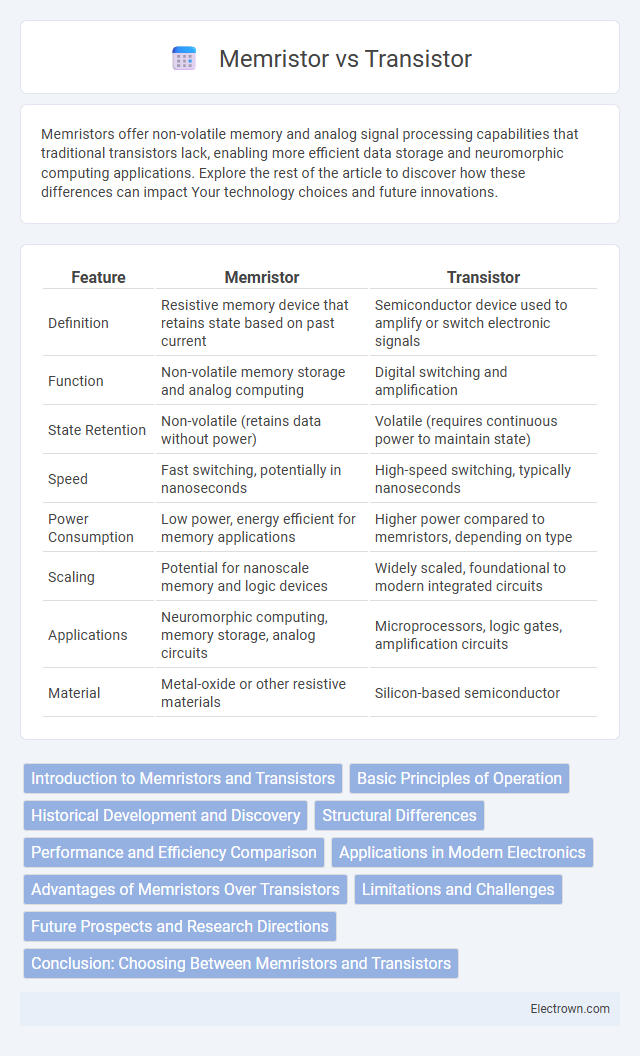Memristors offer non-volatile memory and analog signal processing capabilities that traditional transistors lack, enabling more efficient data storage and neuromorphic computing applications. Explore the rest of the article to discover how these differences can impact Your technology choices and future innovations.
Table of Comparison
| Feature | Memristor | Transistor |
|---|---|---|
| Definition | Resistive memory device that retains state based on past current | Semiconductor device used to amplify or switch electronic signals |
| Function | Non-volatile memory storage and analog computing | Digital switching and amplification |
| State Retention | Non-volatile (retains data without power) | Volatile (requires continuous power to maintain state) |
| Speed | Fast switching, potentially in nanoseconds | High-speed switching, typically nanoseconds |
| Power Consumption | Low power, energy efficient for memory applications | Higher power compared to memristors, depending on type |
| Scaling | Potential for nanoscale memory and logic devices | Widely scaled, foundational to modern integrated circuits |
| Applications | Neuromorphic computing, memory storage, analog circuits | Microprocessors, logic gates, amplification circuits |
| Material | Metal-oxide or other resistive materials | Silicon-based semiconductor |
Introduction to Memristors and Transistors
Memristors and transistors are fundamental components in modern electronics, with memristors serving as non-volatile memory elements that retain resistance levels based on the history of voltage and current. Transistors function as semiconductor switches or amplifiers controlling electrical signals, crucial for digital logic circuits and microprocessors. Your understanding of these devices highlights their complementary roles in advancing memory storage, processing speed, and energy efficiency in computing technology.
Basic Principles of Operation
Memristors operate by regulating resistance through the movement of ions or defects within a material, enabling memory retention without power. Transistors function by controlling current flow via semiconductor junctions, acting as switches or amplifiers in circuits. While transistors rely on voltage-controlled gate terminals, memristors leverage resistance modulation for non-volatile data storage and logic operations.
Historical Development and Discovery
Memristors were first theorized by Leon Chua in 1971 as the missing fourth fundamental circuit element, but their practical realization only occurred in 2008 by researchers at HP Labs. Transistors, invented in 1947 at Bell Labs by John Bardeen, Walter Brattain, and William Shockley, revolutionized electronics by replacing bulky vacuum tubes with compact, efficient semiconductor switches. While transistors became the backbone of digital computing for decades, memristors offer promise in non-volatile memory and neuromorphic computing due to their unique ability to retain resistance states.
Structural Differences
Memristors feature a simple sandwich structure composed of two metal electrodes surrounding a thin film of a transition metal oxide, enabling resistance changes based on ionic movement. In contrast, transistors typically consist of semiconductor materials like silicon with multiple layers forming pn-junctions or metal-oxide-semiconductor (MOS) structures for controlling current flow. The fundamental structural distinction lies in memristors' adaptable resistive layer versus transistors' charge carrier modulation regions.
Performance and Efficiency Comparison
Memristors offer superior performance in terms of speed and energy efficiency compared to traditional transistors, enabling faster data processing with lower power consumption. Unlike transistors that rely on charge flow, memristors store information through resistance changes, resulting in non-volatile memory and reduced energy loss. Your electronic devices can achieve enhanced efficiency and performance by incorporating memristor technology, particularly in neuromorphic computing and memory applications.
Applications in Modern Electronics
Memristors offer advantages in non-volatile memory, neuromorphic computing, and resistive switching applications, enabling energy-efficient data storage and brain-inspired AI systems. Transistors remain fundamental in digital logic circuits, microprocessors, and amplifiers, forming the backbone of classical computing and communication technologies. Integration of memristors with transistors is advancing hybrid circuits that enhance performance and reduce power consumption in modern electronic devices.
Advantages of Memristors Over Transistors
Memristors offer significant advantages over transistors, including non-volatile memory storage, which retains data without power, leading to lower energy consumption. Their ability to perform analog computations and store resistance states enables enhanced neuromorphic computing and faster processing speeds. Memristors also provide higher density integration due to their nanoscale size, surpassing traditional transistor scaling limits.
Limitations and Challenges
Memristors face challenges such as variability in switching behavior, limited endurance compared to traditional transistors, and difficulties in large-scale integration with existing CMOS technology. Transistors, while well-established, encounter limitations in scaling below the 5nm node due to short-channel effects, increased leakage currents, and rising power density. Both devices require advancements in materials engineering and manufacturing processes to overcome these barriers for future high-performance, low-power computing applications.
Future Prospects and Research Directions
Memristors offer promising future prospects in next-generation memory storage and neuromorphic computing due to their non-volatile resistance states and energy efficiency, surpassing traditional transistors in density and scalability. Current research focuses on enhancing material stability, switching speed, and integration with CMOS technology to overcome fabrication challenges and improve device reliability. Ongoing advancements aim to unlock memristors' potential for mimicking synaptic functions, enabling breakthroughs in artificial intelligence and low-power computing architectures.
Conclusion: Choosing Between Memristors and Transistors
Choosing between memristors and transistors depends on your specific application needs, as memristors offer non-volatile memory capabilities and energy-efficient data storage, while transistors provide faster switching speeds and established reliability in digital circuits. Memristors excel in neuromorphic computing and memory-intensive tasks, whereas transistors remain fundamental for general-purpose processing and amplification. Evaluating performance requirements, power consumption, and integration complexity will guide your optimal choice between these two key semiconductor technologies.
Memristor vs Transistor Infographic

 electrown.com
electrown.com